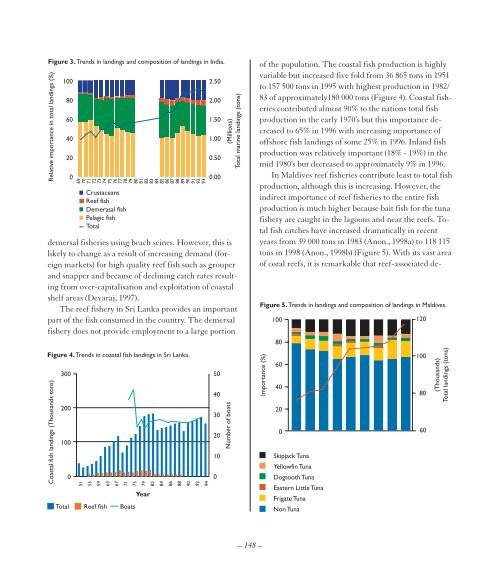Create successful ePaper yourself
Turn your PDF publications into a flip-book with our unique Google optimized e-Paper software.
Figure 3. Trends in landings and composition of landings in India.<br />
Relative importance in total landings (%)<br />
100<br />
80<br />
60<br />
40<br />
20<br />
0<br />
69<br />
70<br />
71<br />
72<br />
73<br />
74<br />
75<br />
76<br />
77<br />
78<br />
79<br />
80<br />
81<br />
82<br />
83<br />
84<br />
85<br />
86<br />
87<br />
88<br />
89<br />
90<br />
91<br />
92<br />
93<br />
Crustaceans<br />
Reef fish<br />
Demerasal fish<br />
Pelagic fish<br />
Total<br />
demersal fisheries using beach seines. However, this is<br />
likely to change as a result of increasing demand (foreign<br />
markets) for high quality reef fish such as grouper<br />
and snapper and because of declining catch rates resulting<br />
from over-capitalisation and exploitation of coastal<br />
shelf areas (Devaraj, 1997).<br />
The reef fishery in Sri Lanka provides an important<br />
part of the fish consumed in the country. The demersal<br />
fishery does not provide employment to a large portion<br />
Figure 4. Trends in coastal fish landings in Sri Lanka.<br />
Coastal fish landings (Thousands tons)<br />
300<br />
200<br />
100<br />
0<br />
51<br />
55<br />
59<br />
63<br />
67<br />
71<br />
75<br />
Total Reef fish Boats<br />
79<br />
Year<br />
82<br />
84<br />
86<br />
88<br />
90<br />
92<br />
94<br />
2.50<br />
2.00<br />
1.50<br />
1.00<br />
0.50<br />
0.00<br />
50<br />
40<br />
30<br />
20<br />
10<br />
0<br />
(Millions)<br />
Total marine landings (tons)<br />
Number of boats<br />
of the population. The coastal fish production is highly<br />
variable but increased five fold from 36 865 tons in 1951<br />
to 157 500 tons in 1995 with highest production in 1982/<br />
83 of approximately180 000 tons (Figure 4). Coastal fisheries<br />
contributed almost 90% to the nations total fish<br />
production in the early 1970’s but this importance decreased<br />
to 65% in 1996 with increasing importance of<br />
offshore fish landings of some 25% in 1996. Inland fish<br />
production was relatively important (18% - 19%) in the<br />
mid 1980’s but decreased to approximately 9% in 1996.<br />
In Maldives reef fisheries contribute least to total fish<br />
production, although this is increasing. However, the<br />
indirect importance of reef fisheries to the entire fish<br />
production is much higher because bait fish for the tuna<br />
fishery are caught in the lagoons and near the reefs. Total<br />
fish catches have increased dramatically in recent<br />
years from 39 000 tons in 1983 (Anon., 1998a) to 118 115<br />
tons in 1998 (Anon., 1998b) (Figure 5). With its vast area<br />
of coral reefs, it is remarkable that reef-associated de-<br />
Figure 5. Trends in landings and composition of landings in Maldives.<br />
Importance (%)<br />
100<br />
80<br />
60<br />
40<br />
20<br />
0<br />
Skipjack Tuna<br />
Yellowfin Tuna<br />
Dogtooth Tuna<br />
Eastern Little Tuna<br />
Frigate Tuna<br />
Non Tuna<br />
120<br />
100<br />
80<br />
60<br />
(Thousands)<br />
Total landings (tons)<br />
– 148 –


















